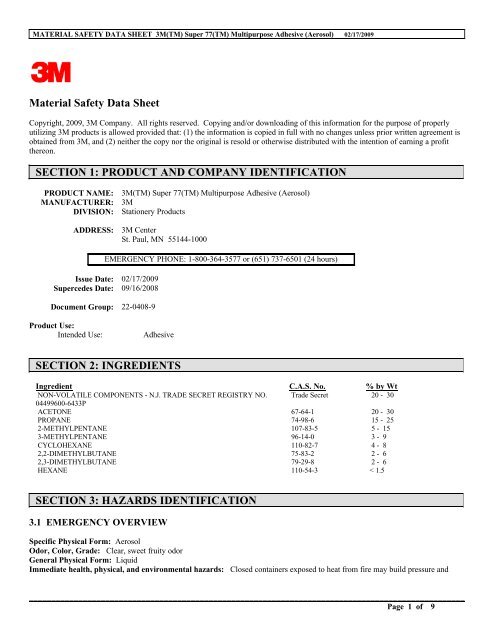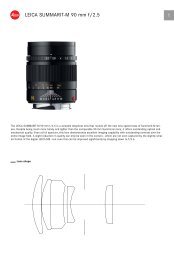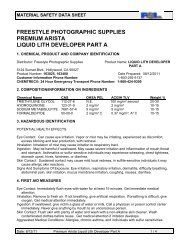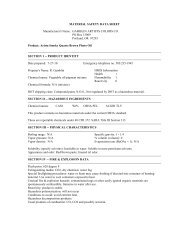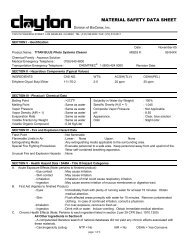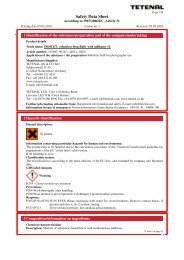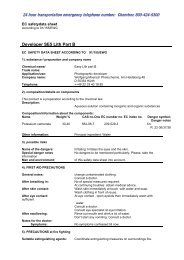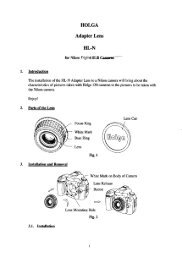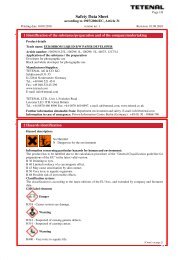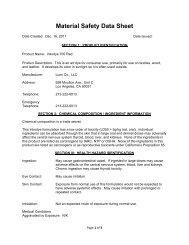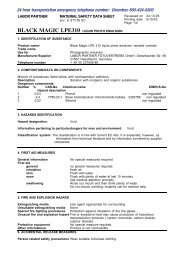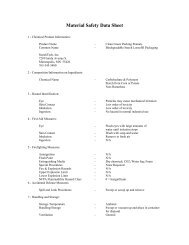3M Super 77 Spray Adhesive
3M Super 77 Spray Adhesive
3M Super 77 Spray Adhesive
Create successful ePaper yourself
Turn your PDF publications into a flip-book with our unique Google optimized e-Paper software.
MATERIAL SAFETY DATA SHEET <strong>3M</strong>(TM) <strong>Super</strong> <strong>77</strong>(TM) Multipurpose <strong>Adhesive</strong> (Aerosol) 02/17/2009<br />
Material Safety Data Sheet<br />
Copyright, 2009, <strong>3M</strong> Company. All rights reserved. Copying and/or downloading of this information for the purpose of properly<br />
utilizing <strong>3M</strong> products is allowed provided that: (1) the information is copied in full with no changes unless prior written agreement is<br />
obtained from <strong>3M</strong>, and (2) neither the copy nor the original is resold or otherwise distributed with the intention of earning a profit<br />
thereon.<br />
SECTION 1: PRODUCT AND COMPANY IDENTIFICATION<br />
PRODUCT NAME: <strong>3M</strong>(TM) <strong>Super</strong> <strong>77</strong>(TM) Multipurpose <strong>Adhesive</strong> (Aerosol)<br />
MANUFACTURER: <strong>3M</strong><br />
DIVISION: Stationery Products<br />
ADDRESS: <strong>3M</strong> Center<br />
St. Paul, MN 55144-1000<br />
EMERGENCY PHONE: 1-800-364-35<strong>77</strong> or (651) 737-6501 (24 hours)<br />
Issue Date: 02/17/2009<br />
<strong>Super</strong>cedes Date: 09/16/2008<br />
Document Group: 22-0408-9<br />
Product Use:<br />
Intended Use: <strong>Adhesive</strong><br />
SECTION 2: INGREDIENTS<br />
Ingredient C.A.S. No. % by Wt<br />
NON-VOLATILE COMPONENTS - N.J. TRADE SECRET REGISTRY NO.<br />
04499600-6433P<br />
Trade Secret 20 - 30<br />
ACETONE 67-64-1 20 - 30<br />
PROPANE 74-98-6 15 - 25<br />
2-METHYLPENTANE 107-83-5 5 - 15<br />
3-METHYLPENTANE 96-14-0 3 - 9<br />
CYCLOHEXANE 110-82-7 4 - 8<br />
2,2-DIMETHYLBUTANE 75-83-2 2 - 6<br />
2,3-DIMETHYLBUTANE 79-29-8 2 - 6<br />
HEXANE 110-54-3 < 1.5<br />
SECTION 3: HAZARDS IDENTIFICATION<br />
3.1 EMERGENCY OVERVIEW<br />
Specific Physical Form: Aerosol<br />
Odor, Color, Grade: Clear, sweet fruity odor<br />
General Physical Form: Liquid<br />
Immediate health, physical, and environmental hazards: Closed containers exposed to heat from fire may build pressure and<br />
_________________________________________________________________________________________________<br />
Page 1 of 9
MATERIAL SAFETY DATA SHEET <strong>3M</strong>(TM) <strong>Super</strong> <strong>77</strong>(TM) Multipurpose <strong>Adhesive</strong> (Aerosol) 02/17/2009<br />
explode. Extremely flammable liquid and vapor. Vapors may travel long distances along the ground or floor to an ignition source and<br />
flash back. Aerosol container contains flammable material under pressure. May cause target organ effects. Contains a<br />
chemical or chemicals which can cause birth defects or other reproductive harm.<br />
3.2 POTENTIAL HEALTH EFFECTS<br />
Eye Contact:<br />
Moderate Eye Irritation: Signs/symptoms may include redness, swelling, pain, tearing, and blurred or hazy vision.<br />
Skin Contact:<br />
Mild Skin Irritation: Signs/symptoms may include localized redness, swelling, and itching.<br />
May be absorbed through skin and cause target organ effects.<br />
Inhalation:<br />
Intentional concentration and inhalation may be harmful or fatal.<br />
Respiratory Tract Irritation: Signs/symptoms may include cough, sneezing, nasal discharge, headache, hoarseness, and nose and<br />
throat pain.<br />
Single exposure, above recommended guidelines, may cause:<br />
Cardiac Sensitization: Signs/symptoms may include irregular heartbeat (arrhythmia), faintness, chest pain, and may be fatal.<br />
Simple Asphyxiation: Signs/symptoms may include increased heart rate, rapid respirations, drowsiness, headache,<br />
incoordination, altered judgement, nausea, vomiting, lethargy, seizures, coma, and may be fatal.<br />
May be absorbed following inhalation and cause target organ effects.<br />
Ingestion:<br />
Gastrointestinal Irritation: Signs/symptoms may include abdominal pain, stomach upset, nausea, vomiting and diarrhea.<br />
May be absorbed following ingestion and cause target organ effects.<br />
Target Organ Effects:<br />
Central Nervous System (CNS) Depression: Signs/symptoms may include headache, dizziness, drowsiness, incoordination, nausea,<br />
slowed reaction time, slurred speech, giddiness, and unconsciousness.<br />
Prolonged or repeated exposure may cause:<br />
Peripheral Neuropathy: Signs/symptoms may include tingling or numbness of the extremities, incoordination, weakness of<br />
the hands and feet, tremors and muscle atrophy.<br />
Dermal Effects: Signs/symptoms may include localized redness, itching, drying and cracking of skin.<br />
Contains a chemical or chemicals which can cause birth defects or other reproductive harm.<br />
_________________________________________________________________________________________________<br />
Page 2 of 9
MATERIAL SAFETY DATA SHEET <strong>3M</strong>(TM) <strong>Super</strong> <strong>77</strong>(TM) Multipurpose <strong>Adhesive</strong> (Aerosol) 02/17/2009<br />
SECTION 4: FIRST AID MEASURES<br />
4.1 FIRST AID PROCEDURES<br />
The following first aid recommendations are based on an assumption that appropriate personal and industrial hygiene practices are<br />
followed.<br />
Eye Contact: Flush eyes with large amounts of water. If signs/symptoms persist, get medical attention.<br />
Skin Contact: Wash affected area with soap and water. If signs/symptoms develop, get medical attention.<br />
Inhalation: Remove person to fresh air. Get immediate medical attention.<br />
If Swallowed: Do not induce vomiting unless instructed to do so by medical personnel. Give victim two glasses of water. Never<br />
give anything by mouth to an unconscious person. Get medical attention.<br />
SECTION 5: FIRE FIGHTING MEASURES<br />
5.1 FLAMMABLE PROPERTIES<br />
Autoignition temperature No Data Available<br />
Flash Point -42.00 ºF [Test Method: Tagliabue Closed Cup] [Details:<br />
CONDITIONS: Propellant]<br />
Flammable Limits - LEL No Data Available<br />
Flammable Limits - UEL No Data Available<br />
OSHA Flammability Classification: Class IA Flammable Liquid<br />
5.2 EXTINGUISHING MEDIA<br />
Use fire extinguishers with class B extinguishing agents (e.g., dry chemical, carbon dioxide).<br />
5.3 PROTECTION OF FIRE FIGHTERS<br />
Special Fire Fighting Procedures: Water may not effectively extinguish fire; however, it should be used to keep fire-exposed<br />
containers and surfaces cool and prevent explosive rupture. Wear full protective equipment (Bunker Gear) and a self-contained<br />
breathing apparatus (SCBA).<br />
Unusual Fire and Explosion Hazards: Closed containers exposed to heat from fire may build pressure and explode. Extremely<br />
flammable liquid and vapor. Vapors may travel long distances along the ground or floor to an ignition source and flash back. Aerosol<br />
container contains flammable material under pressure.<br />
Note: See STABILITY AND REACTIVITY (SECTION 10) for hazardous combustion and thermal decomposition<br />
information.<br />
SECTION 6: ACCIDENTAL RELEASE MEASURES<br />
Accidental Release Measures: Refer to other sections of this MSDS for information regarding physical and health hazards,<br />
respiratory protection, ventilation, and personal protective equipment. Call <strong>3M</strong>-HELPS line (1-800-364-35<strong>77</strong>) for more information<br />
on handling and managing the spill. Evacuate unprotected and untrained personnel from hazard area. The spill should be cleaned up<br />
by qualified personnel. Remove all ignition sources such as flames, smoking materials, and electrical spark sources. Use only nonsparking<br />
tools. Ventilate the area with fresh air. For large spill, or spills in confined spaces, provide mechanical ventilation to<br />
disperse or exhaust vapors, in accordance with good industrial hygiene practice. Warning! A motor could be an ignition source and<br />
could cause flammable gases or vapors in the spill area to burn or explode. Contain spill. For larger spills, cover drains and build<br />
_________________________________________________________________________________________________<br />
Page 3 of 9
MATERIAL SAFETY DATA SHEET <strong>3M</strong>(TM) <strong>Super</strong> <strong>77</strong>(TM) Multipurpose <strong>Adhesive</strong> (Aerosol) 02/17/2009<br />
dikes to prevent entry into sewer systems or bodies of water. If possible, seal leaking container. Place leaking containers in a wellventilated<br />
area, preferably an operating exhaust hood, or if necessary outdoors on an impermeable surface until appropriate packaging<br />
for the leaking container or its contents is available. Cover spill area with a fire-extinguishing foam. An aqueous film forming foam<br />
(AFFF) is recommended. Working from around the edges of the spill inward, cover with bentonite, vermiculite, or commercially<br />
available inorganic absorbent material. Mix in sufficient absorbent until it appears dry. Remember, adding an absorbent material does<br />
not remove a toxic, corrosivity or flammability hazard. Collect as much of the spilled material as possible using non-sparking tools.<br />
Clean up residue with an appropriate organic solvent. Read and follow safety precautions on the solvent label and MSDS. Collect the<br />
resulting residue containing solution. Place in a metal container approved for transportation by appropriate authorities. Seal the<br />
container. Dispose of collected material as soon as possible.<br />
In the event of a release of this material, the user should determine if the release qualifies as reportable according to<br />
local, state, and federal regulations.<br />
SECTION 7: HANDLING AND STORAGE<br />
7.1 HANDLING<br />
Do not eat, drink or smoke when using this product. Wash exposed areas thoroughly with soap and water. Keep away from heat,<br />
sparks, open flame, pilot lights and other sources of ignition. Ground containers securely when transferring contents. Wear low static<br />
or properly grounded shoes. Do not pierce or burn container, even after use. No smoking while handling this material. Do not spray<br />
near flames or sources of ignition. Avoid breathing of vapors, mists or spray. Avoid static discharge. Avoid eye contact with vapors,<br />
mists, or spray. Keep out of the reach of children. Vapors may ignite explosively. May cause flash fire. Prevent build-up of vapors -<br />
open all windows and doors. Maintain vapor concentrations below recommended exposure limits. Use only with cross-ventilation.<br />
Without adequate ventilation, vapors may settle in low-lying areas. Keep away from heat, sparks, and open flame. Do not smoke or<br />
ignite matches, lighters, etc. Do not breathe vapors. Avoid contact with oxidizing agents.<br />
7.2 STORAGE<br />
Store away from acids. Store away from heat. Store out of direct sunlight. Keep container tightly closed. Do not store containers on<br />
their sides. Store away from oxidizing agents.<br />
SECTION 8: EXPOSURE CONTROLS/PERSONAL PROTECTION<br />
8.1 ENGINEERING CONTROLS<br />
Use in an enclosed process area is recommended. Do not use in a confined area or areas with little or no air movement. Do not<br />
remain in area where available oxygen may be reduced. Use general dilution ventilation and/or local exhaust ventilation to control<br />
airborne exposures to below Occupational Exposure Limits and/or control mist, vapor, or spray. If ventilation is not adequate, use<br />
respiratory protection equipment. Do not use in a confined area or areas with little or no air movement. If exhaust ventilation is not<br />
adequate, use appropriate respiratory protection. Provide ventilation adequate to control vapor concentrations below recommended<br />
exposure limits and/or control spray or mist.<br />
8.2 PERSONAL PROTECTIVE EQUIPMENT (PPE)<br />
8.2.1 Eye/Face Protection<br />
Avoid eye contact with vapors, mists, or spray.<br />
The following eye protection(s) are recommended: Indirect Vented Goggles.<br />
8.2.2 Skin Protection<br />
Avoid skin contact.<br />
Select and use gloves and/or protective clothing to prevent skin contact based on the results of an exposure assessment. Consult with<br />
your glove and/or protective clothing manufacturer for selection of appropriate compatible materials.<br />
Gloves made from the following material(s) are recommended: Fluoroelastomer (Viton), Nitrile Rubber, Polyvinyl Alcohol (PVA),<br />
_________________________________________________________________________________________________<br />
Page 4 of 9
MATERIAL SAFETY DATA SHEET <strong>3M</strong>(TM) <strong>Super</strong> <strong>77</strong>(TM) Multipurpose <strong>Adhesive</strong> (Aerosol) 02/17/2009<br />
Polyethylene/Ethylene Vinyl Alcohol.<br />
8.2.3 Respiratory Protection<br />
Avoid breathing of vapors, mists or spray. Do not breathe vapors.<br />
Select one of the following NIOSH approved respirators based on airborne concentration of contaminants and in accordance with<br />
OSHA regulations: Half facepiece or fullface air-purifying respirator with organic vapor cartridges, Half facepiece or fullface<br />
pressure demand self-contained breathing apparatus. Consult the current <strong>3M</strong> Respiratory Selection Guide for additional information<br />
or call 1-800-243-4630 for <strong>3M</strong> technical assistance.<br />
8.2.4 Prevention of Swallowing<br />
Do not eat, drink or smoke when using this product. Wash exposed areas thoroughly with soap and water.<br />
8.3 EXPOSURE GUIDELINES<br />
Ingredient Authority Type Limit Additional Information<br />
ACETONE ACGIH TWA 500 ppm Table A4<br />
ACETONE ACGIH STEL 750 ppm Table A4<br />
ACETONE OSHA TWA, Vacated 750 ppm<br />
ACETONE OSHA TWA 1000 ppm Table Z-1<br />
ACETONE OSHA STEL, Vacated 1000 ppm<br />
CYCLOHEXANE ACGIH TWA 100 ppm<br />
CYCLOHEXANE OSHA TWA 300 ppm Table Z-1<br />
HEXANE ACGIH TWA 50 ppm Skin Notation*<br />
HEXANE OSHA TWA, Vacated 50 ppm Table Z-1A<br />
HEXANE OSHA TWA 500 ppm Table Z-1A<br />
HEXANE (ISOMERS OTHER THAN N-<br />
HEXANE)<br />
ACGIH TWA 500 ppm<br />
HEXANE (ISOMERS OTHER THAN N- ACGIH STEL 1000 ppm<br />
HEXANE)<br />
PROPANE ACGIH TWA 1000 ppm<br />
PROPANE OSHA TWA 1000 ppm Table Z-1<br />
* Substance(s) refer to the potential contribution to the overall exposure by the cutaneous route including mucous membrane and eye,<br />
either by airborne or, more particularly, by direct contact with the substance. Vehicles can alter skin absorption.<br />
VAC Vacated PEL:Vacated Permissible Exposure Limits [PEL] are enforced as the OSHA PEL in some states. Check with your local<br />
regulatory agency.<br />
SOURCE OF EXPOSURE LIMIT DATA:<br />
ACGIH: American Conference of Governmental Industrial Hygienists<br />
CMRG: Chemical Manufacturer Recommended Guideline<br />
OSHA: Occupational Safety and Health Administration<br />
AIHA: American Industrial Hygiene Association Workplace Environmental Exposure Level (WEEL)<br />
SECTION 9: PHYSICAL AND CHEMICAL PROPERTIES<br />
Specific Physical Form: Aerosol<br />
Odor, Color, Grade: Clear, sweet fruity odor<br />
General Physical Form: Liquid<br />
Autoignition temperature No Data Available<br />
Flash Point -42.00 ºF [Test Method: Tagliabue Closed Cup] [Details:<br />
CONDITIONS: Propellant]<br />
Flammable Limits - LEL No Data Available<br />
Flammable Limits - UEL No Data Available<br />
Boiling point Not Applicable<br />
_________________________________________________________________________________________________<br />
Page 5 of 9
MATERIAL SAFETY DATA SHEET <strong>3M</strong>(TM) <strong>Super</strong> <strong>77</strong>(TM) Multipurpose <strong>Adhesive</strong> (Aerosol) 02/17/2009<br />
Density 0.726 g/ml<br />
Vapor Density 2.97 [Ref Std: AIR=1]<br />
Specific Gravity 0.726 [Ref Std: WATER=1]<br />
pH Not Applicable<br />
Melting point Not Applicable<br />
Solubility in Water Negligible<br />
Evaporation rate 1.90 [Ref Std: ETHER=1]<br />
Hazardous Air Pollutants 0.4 % weight [Test Method: Calculated]<br />
Hazardous Air Pollutants 0.016 lb HAPS/lb solids<br />
Hazardous Air Pollutants 0.02 lb HAPS/gal [Test Method: Calculated]<br />
Volatile Organic Compounds Approximately 51 % [Test Method: calculated SCAQMD rule<br />
443.1]<br />
Percent volatile
MATERIAL SAFETY DATA SHEET <strong>3M</strong>(TM) <strong>Super</strong> <strong>77</strong>(TM) Multipurpose <strong>Adhesive</strong> (Aerosol) 02/17/2009<br />
Not determined.<br />
SECTION 13: DISPOSAL CONSIDERATIONS<br />
Waste Disposal Method: Incinerate in a permitted hazardous waste incinerator. As a disposal alternative, dispose of waste product<br />
in a permitted hazardous waste facility.<br />
Facility must be capable of handling aerosol cans. Dispose of empty product containers in a sanitary landfill.<br />
EPA Hazardous Waste Number (RCRA): D001 (Ignitable)<br />
Since regulations vary, consult applicable regulations or authorities before disposal.<br />
SECTION 14:TRANSPORT INFORMATION<br />
ID Number(s):<br />
62-49<strong>77</strong>-2926-9, 62-49<strong>77</strong>-4830-1, 70-0050-1481-9, 70-0050-1706-9, 70-0050-1808-3, 70-0050-1809-1, 70-0714-2173-2, 70-0714-<br />
2194-8, 70-0714-8197-5, 70-0714-9203-0, 70-0714-9575-1<br />
Please contact the emergency numbers listed on the first page of the MSDS for Transportation Information for this<br />
material.<br />
SECTION 15: REGULATORY INFORMATION<br />
US FEDERAL REGULATIONS<br />
Contact <strong>3M</strong> for more information.<br />
311/312 Hazard Categories:<br />
Fire Hazard - Yes Pressure Hazard - Yes Reactivity Hazard - No Immediate Hazard - Yes Delayed Hazard - Yes<br />
Section 313 Toxic Chemicals subject to the reporting requirements of that section and 40 CFR part 372 (EPCRA):<br />
Ingredient C.A.S. No % by Wt<br />
CYCLOHEXANE 110-82-7 4 - 8<br />
HEXANE 110-54-3 < 1.5<br />
This material contains a chemical which requires export notification under TSCA Section 12[b]:<br />
Ingredient (Category if applicable) C.A.S. No Regulation Status<br />
CYCLOHEXANE 110-82-7 Toxic Substances Control Act (TSCA) 4 Test<br />
Rule Chemicals<br />
Applicable<br />
STATE REGULATIONS<br />
Contact <strong>3M</strong> for more information.<br />
_________________________________________________________________________________________________<br />
Page 7 of 9
MATERIAL SAFETY DATA SHEET <strong>3M</strong>(TM) <strong>Super</strong> <strong>77</strong>(TM) Multipurpose <strong>Adhesive</strong> (Aerosol) 02/17/2009<br />
CHEMICAL INVENTORIES<br />
The components of this product are in compliance with the chemical notification requirements of TSCA.<br />
All applicable chemical ingredients in this material are listed on the European Inventory of Existing Chemical Substances (EINECS),<br />
or are exempt polymers whose monomers are listed on EINECS.<br />
Contact <strong>3M</strong> for more information.<br />
INTERNATIONAL REGULATIONS<br />
Non hazardous according to WHMIS criteria.<br />
This material contains one or more ingredients that may be regulated by the International Traffic in Arms Regulation (ITAR), an<br />
export control of US military technology and chemicals. Prior to export of this material or any product containing this material,<br />
determine whether a proper license from the Department of State must be obtained. See 22CFR 120-130 for any specific requirements.<br />
Contact <strong>3M</strong> for more information.<br />
WHMIS: Non-hazardous<br />
This MSDS has been prepared to meet the U.S. OSHA Hazard Communication Standard, 29 CFR 1910.1200.<br />
SECTION 16: OTHER INFORMATION<br />
NFPA Hazard Classification<br />
Health: 2 Flammability: 4 Reactivity: 0 Special Hazards: None<br />
Aerosol Storage Code: 3<br />
National Fire Protection Association (NFPA) hazard ratings are designed for use by emergency response personnel to address the hazards that are<br />
presented by short-term, acute exposure to a material under conditions of fire, spill, or similar emergencies. Hazard ratings are primarily based on the<br />
inherent physical and toxic properties of the material but also include the toxic properties of combustion or decomposition products that are known to<br />
be generated in significant quantities.<br />
HMIS Hazard Classification<br />
Health: 2 Flammability: 4 Reactivity: 0 Protection: X - See PPE section.<br />
Hazardous Material Identification System (HMIS(r)) hazard ratings are designed to inform employees of chemical hazards in the workplace. These<br />
ratings are based on the inherent properties of the material under expected conditions of normal use and are not intended for use in emergency<br />
situations. HMIS(r) ratings are to be used with a fully implemented HMIS(r) program. HMIS(r) is a registered mark of the National Paint and<br />
Coatings Association (NPCA).<br />
Revision Changes:<br />
_________________________________________________________________________________________________<br />
Page 8 of 9
MATERIAL SAFETY DATA SHEET <strong>3M</strong>(TM) <strong>Super</strong> <strong>77</strong>(TM) Multipurpose <strong>Adhesive</strong> (Aerosol) 02/17/2009<br />
Copyright was modified.<br />
Section 14: ID Number(s) Template 1 was modified.<br />
Section 2: Ingredient table was modified.<br />
DISCLAIMER: The information in this Material Safety Data Sheet (MSDS) is believed to be correct as of the date issued. <strong>3M</strong><br />
MAKES NO WARRANTIES, EXPRESSED OR IMPLIED, INCLUDING, BUT NOT LIMITED TO, ANY IMPLIED WARRANTY<br />
OF MERCHANTABILITY OR FITNESS FOR A PARTICULAR PURPOSE OR COURSE OF PERFORMANCE OR USAGE OF<br />
TRADE. User is responsible for determining whether the <strong>3M</strong> product is fit for a particular purpose and suitable for user's method of<br />
use or application. Given the variety of factors that can affect the use and application of a <strong>3M</strong> product, some of which are uniquely<br />
within the user's knowledge and control, it is essential that the user evaluate the <strong>3M</strong> product to determine whether it is fit for a<br />
particular purpose and suitable for user's method of use or application.<br />
<strong>3M</strong> provides information in electronic form as a service to its customers. Due to the remote possibility that electronic transfer may<br />
have resulted in errors, omissions or alterations in this information, <strong>3M</strong> makes no representations as to its completeness or accuracy.<br />
In addition, information obtained from a database may not be as current as the information in the MSDS available directly from <strong>3M</strong>.<br />
<strong>3M</strong> MSDSs are available at www.<strong>3M</strong>.com<br />
_________________________________________________________________________________________________<br />
Page 9 of 9


